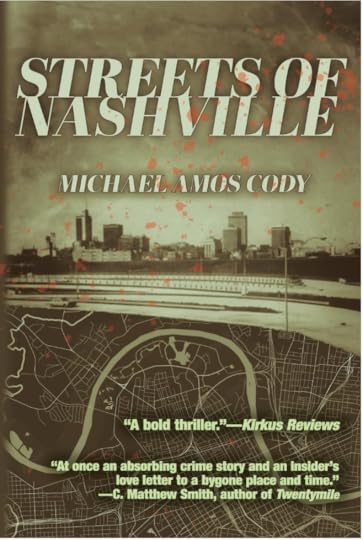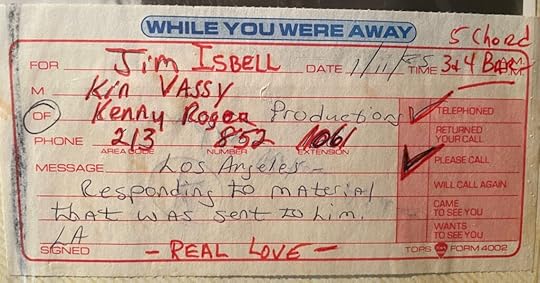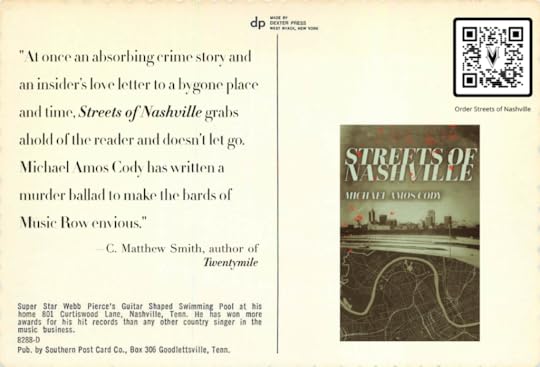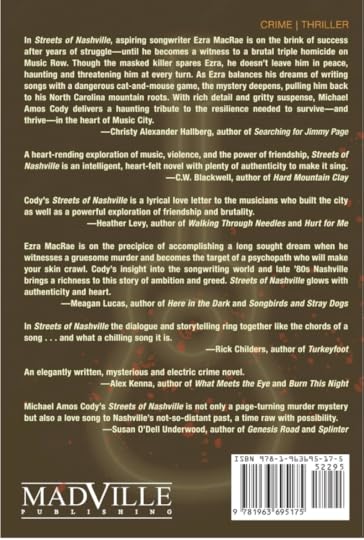Michael Amos Cody's Blog, page 2
May 20, 2025
Song Stories: “Big Rain’s Coming”
 Streets of Nashville
Streets of Nashvillefrom Madville Publishing
Ezra MacRae has moved from the North Carolina mountains to Nashville’s Music Row with the dream of becoming part of that songwriting world.
“An elegantly written, mysterious and electric crime novel.”
—Alex Kenna, author of What Meets the Eye and Burn This Night
In what were originally the first scenes written for Streets of Nashville (eventually folded into chapter six), songwriter Ezra MacRae is more than a little bit drunk and walking on Music Row just before midnight. He has been celebrating his first songwriting successes after five fruitless years of struggling to be heard. Little does he know that the next couple of hours will rock his world. He’ll witness devastating violence that threatens to overwhelm his joy, but he also experiences an encounter that will gift him with a friendship and his first hit song.
Keeping an eye on an approaching storm, Ezra heads for the Hall of Fame Motel’s Sound Track Restaurant & Lounge, some place “dry but not dry,” where he can keep drinking while he waits out the rain.


Ezra and Benny Jack talk for a little. Then the rain is on the verge of beginning, and Benny Jack gets lost somewhere inside his mind.
Sometime later, after the storm has passed, Ezra resumes his walk home in the wee hours of Easter Sunday morning. As he walks, his songwriter’s mind revs up for a few ideas.

With those words, Ezra walks into a storm of a very different and deadly kind.
Chapter Twenty-Two finds him locked in songwriting mode and writing the two main verses. He writes the bridge in Chapter Thirty-Three.
Here I am “covering” Ezra’s song during a recent visit Read Spotted Newt bookstore in Hazard, Kentucky.
February 13, 2025
Forty-Two Years Ago
I recently stumbled upon a new podcast called Murder on Music Row from journalist Keith Sharon from Nashville’s The Tennessean newspaper. Every episode begins—more or less—with a nod to the song “Murder on Music Row” (written by Larry Cordle and Larry Shell). Over eight episodes, Sharon investigates the terrible March 1989 murder of Kevin Hughes. The journalist’s narration is by turns touching and funny, and he’s gathered a number of interviews with people involved and or adjacent to the murder and subsequent investigation, along with investigative recordings from police files. It’s a rich and heartbreaking story done really well. And well worth a listen. (I finished it in just three days after discovering it.)
In March 1989, I remember being sad at the loss of a young, promising life and at the blemish his murder put on the dazzle of Music Row, a place that still has a hook in my heart, even though it’s vastly changed. I was in the last few months of my life in Nashville that March. Leesa and I had rediscovered each other the previous fall, and in July 1989, my brother Jerry came to Music City and helped me move back home to the western North Carolina mountains so that I could help prepare for a beautiful September 2nd wedding.
But the memory of the murder stayed with me. The story as it plays out in the podcast is certainly worthy of a novel or a true crime book. Whenever I thought of the event, I thought of writing about it but never did so. What I did write, however, was a brief fictionalization of the event and used it to set the tone for Streets of Nashville, coming from Madville Publishing on April 15. I hope that my adaptation of it works as I want it to and that it isn’t disrespectful to the Hughes family.
The podcast made me nostalgic for those Nashville days in the 1980s. You might have read my first novel, Gabriel’s Songbook, published by Pisgah Press in 2017, which fictionalizes my own Nashville experiences through most of the 1980s. I often say that the novel is autobiography in its bones and fiction in its flesh and blood. A number of details in Murder on Music Row jolted me so that a number of connections surfaced.
Here’s an excerpted image from an email I sent to Keith Sharon when I was about halfway through the series:

As I listened, I began to wonder how close I came to being caught up in the dangerous scams operating on the underbelly of Music Row. I never lost any money paying for radio plays or record promotion for “Fiesta” (1983), my only released record (a 45 rpm, for any who remember those). But I’ve never been sure how closely my producer/publisher Earl Richards swerved in that direction, and I’m still torn as to whether or not my five years under his direction was good or bad for me, legit or illegit.
So, the forty-two years mentioned in the title of this post? I know that March 9, 2025, will be the thirty-sixth anniversary of Kevin Hughes’s horrible death. My math isn’t that bad. No, the forty-two years takes me back to 1983, when the 45 of “Fiesta” was released to radio and retail. Listening to Keith Sharon’s podcast, as I said, made me nostalgic, and I went to my scrapbook for those Nashville years. Here are some photos from that mid-to-late spring of 1983.








The memo below is from a couple of years later, 1985, when Kin Vassy called from California to say Kenny Rogers was interested in my song “Real Love.” Nothing ever came of that interest, but it was an exciting possibility for a while!

Heady days for a young man from Walnut, NC
Postcards for Promotion
With thanks to all the blurbers—
C.W. Blackwell, author of Hard Mountain ClayRick Childers, author of TurkeyfootChristy Alexander Hallberg, author of Searching for Jimmy PageAlex Kenna, author of What Meets the Eye and Burn This NightHeather Levy, author of Walking Through Needles and Hurt for MeMeagan Lucas, author of Here in the DarkC. Matthew Smith, author of TwentymileSusan O’Dell Underwood, author of the novel Genesis Road and Splinter: PoemsAlso thanks to ETSU’s Lydia Carr, one of our terrific Executive Aide’s in the Department of Literature & Language.








And here’s one Lydia created from Kirkus Reviews:

Madville Publishing will release Streets of Nashville on August 15, 2025. A week later, 7:00 p.m. on April 22, I’ll participate in a book launch for the novel in downtown Johnson City, TN, hosted by Atlas Books at The Generalist. Y’all come!

January 29, 2025
For Those Who Celebrate . . .
. . . the return of Trump, especially those claiming Christianity, I point to . . .
. . . this from John Pavlovitz: “Dear Carrie Underwood”
. . . this from Ben Cremer regarding a bishop’s prayer for mercy:
An appeal to mercy for demonized groups challenges the narratives that demonize them.
When you worship power, things like mercy, empathy, and compassion will begin to sound like a compromise or a weakness, or even worse, they will sound like sins. When you worship power, the structures and people who maintain that power must prioritize authority, not mercy, forgiveness, or compassion. When you worship power, the more ruthless you are towards those you’ve already chosen to see as your ‘enemies,’ the more righteous you become. When you worship power, you see power as synonymous with the truth, and the truth should never be questioned or criticized. The worship of power has no room for mercy. This worship of power is why authoritarianism has become so appealing to far too many Christians. This worship of power is why the appeal to mercy is treated like a threat.
. . . [Y]ou will see certain politicians and pastors alike being supported by many Christians for high positions of power, no matter their crimes or abuses towards others, because as long as they are willing to use their power in order to protect and enforce what they believe to be “Christian values,” their moral character doesn’t matter. Securing and maintaining power is all that matters in this belief system.
. . . [O]ne of the most blatant forms of Christian hypocrisy in our time right now is Christians holding all the ordinary people we share this country with accountable to the most rigid moral standards while simultaneously holding their preferred politicians accountable to no standards at all. The greater the power one has, the less they will be held accountable to any moral standard. That’s what worshiping power looks like.
. . . Evangelical Christian leader Russell Moore said that multiple pastors had told him disturbing stories about their congregants being upset when they read from the ” Sermon on the Mount” in which Jesus espoused the principles of forgiveness and mercy that are central to Christian doctrine. “Multiple pastors tell me, essentially, the same story about quoting Jesus in the Sermon on the Mount – [and] to have someone come up after to say, ‘Where did you get those liberal talking points?” Moore added: “And what was alarming to me is that in most of these scenarios, when the pastor would say, I’m literally quoting Jesus Christ, the response would be, ‘Yes, but that doesn’t work anymore. That’s weak.”
. . . [N]owhere in the gospel accounts is Jesus seen checking someone’s legal status before welcoming them. Nowhere in the gospel accounts is Jesus seen making sure someone has a job before he “hands out” food to them. Nowhere in the gospel accounts is Jesus seen making sure someone was straight so could make sure he wasn’t “tolerating sin” by spending time with them.
As [a] powerful woman of God once said, “Jesus was not killed by atheism and anarchy. He was brought down by law and order allied with religion – which is always a deadly mix. Beware those who claim to know the will of God and are prepared to use force, if necessary, to make others conform. Beware those who cannot tell God’s will from their own.” (Rev. Dr. Barbara Brown Taylor)
“Blessed are the merciful, for they shall be shown mercy.” (Jesus)
Rev. Cremer invites us to (re)visit John 3:16-17 (not just the 16th verse) and Romans 1:29-32.
In the days of I Samuel 8, the people demanded a king. Samuel took his distress over this to God, who told him that the people weren’t rejecting his leadership but instead were rejecting God—”forsaking me and serving other gods.” In the face of the people’s rejection of faith in God, Samuel was instructed to be sure the people knew what they were asking, to be sure they understood the choice they were making.
So Samuel told the people what God said:
“This is what the king who will reign over you will claim as his rights: He will take your sons and make them serve with his chariots and horses, and they will run in front of his chariots. 12 Some he will assign to be commanders of thousands and commanders of fifties, and others to plow his ground and reap his harvest, and still others to make weapons of war and equipment for his chariots. 13 He will take your daughters to be perfumers and cooks and bakers. 14 He will take the best of your fields and vineyards and olive groves and give them to his attendants. 15 He will take a tenth of your grain and of your vintage and give it to his officials and attendants. 16 Your male and female servants and the best of your cattle[c] and donkeys he will take for his own use. 17 He will take a tenth of your flocks, and you yourselves will become his slaves. 18 When that day comes, you will cry out for relief from the king you have chosen, but the Lord will not answer you in that day.” (1 Samuel 8: 11-18)
And still they rejected God in favor of a king’s so-called leadership.
I’m not suggesting that previous administrations have been godlike in any way. But except for the 45th administration, the ones I’ve know haven’t been as mean and ignorant as this 47th will be. Except for the 45th, none have so greedily sought to be king. We look for our Samuel to the people, our David to Saul, our Nathan to David, our John the Baptist to Herod.
January 18, 2025
Song Stories: “Michael Furey Is Dead”
Every year between Christmas and Epiphany (January 6), I read James Joyce’s “The Dead,” widely regarded as one of the best short stories ever written in English and the final story in the classic collection Dubliners. The setting is the “Misses Morkan’s annual dance” and dinner party. The hostesses are elderly Miss Kate and Miss Julia Morkan and their niece Mary Jane. The main character is Gabriel Conroy, Julia and Kate’s nephew, whose mother was their late sister.
The party breaks up late, and Gabriel and his wife Gretta make their way through cold and snow to a Dublin hotel for the night. But before they leave the Morkan house, Joyce creates a beautiful scene in which Gretta is standing on the first landing of the stairs, where she is listening so somebody up above playing the piano and a man singing. Gabriel stands at the foot of the stairs looking up at his wife:
He stood still in the gloom of the hall, trying to catch the air that the voice was singing and gazing up at his wife. There was grace and mystery in her attitude as if she were a symbol of something. He asked himself what is a woman standing on the stairs in the shadow, listening to distant music, a symbol of. If he were a painter he would paint her in that attitude. Her blue felt hat would show off the bronze of her hair against the darkness and the dark panels of her skirt would show off the light ones. DISTANT MUSIC he would call the picture if he were a painter.

Later, in their hotel room lit only by streetlights, he asks her about the song she heard, and she tells him it was “The Lass of Aughrim.” When he asks why the song made her cry, she tells him the story from her girlhood, when she was loved by a boy named Michael Furey, who used to sing that song to her. When Gabriel breaks out in peevish anger – just before, he was lusting to get her into bed – and says something cutting about her wanting to visit her native region to rekindle her young love of this Furey boy. That’s when she tells him that Michael Furey is dead. Joyce writes, “Gabriel felt humiliated by the failure of his irony and by the evocation of this figure from the dead, a boy in the gasworks.” He becomes even more flustered when he learns that the boy died of a lung condition and overexposure to the weather when he visited her on a cold and rainy night out of a desire to see her one last time before she left for school.
Gretta cries herself to sleep and leaves Gabriel standing by the window and looking out on the night. He feels tenderly for her having spent all their years together, even their most intimate moments, with this secret “locked in her heart.” He feels sad for himself and for her as he realizes that he perhaps has never loved anybody – not even Gretta: “He had never felt like that himself towards any woman but he knew that such a feeling must be love.”
Joyce’s great story “The Dead” ends, appropriately, with what I consider to be one of the most beautiful paragraphs ever written in English:
A few light taps upon the pane made him turn to the window. It had begun to snow again. He watched sleepily the flakes, silver and dark, falling obliquely in the lamplight. The time had come for him to set out on his journey westward. Yes, the newspapers were right: snow was general all over Ireland. It was falling on every part of the dark central plain, on the treeless hills, falling softly upon the Bog of Allen and, farther westward, softly falling into the dark mutinous Shannon waves. It was falling, too, upon every part of the lonely churchyard on the hill where Michael Furey lay buried. It lay thickly drifted on the crooked crosses and headstones, on the spears of the little gate, on the barren thorns. His soul swooned slowly as he heard the snow falling faintly through the universe and faintly falling, like the descent of their last end, upon all the living and the dead.

I find this so moving that a few years ago, when I was somewhere – Gatlinburg maybe – on a writing weekend away, I attempted to capture some hint of the emotions this conclusion of “The Dead” inspires in me. Below is what I came up with.
Michael Furey Is Dead
She stands on the stair and listens
to the waltz floating down from above,
Her face half hidden in shadow
half in light.
The ghost of a sad smile trembles
on lips freshly colored with care,
And I tremble at the sight
and I wonder what she might be thinking.
She doesn’t know that I saw her
as we walk side by side on the street,
Both acting just like we didn’t feel
what we felt.
My tongue tripping over her mystery,
hers trying to cover it up.
Then I ask her if she’s well,
Then I beg for her to tell what she’s feeling.
Oo Oo Oo—Michael Furey is dead—Oo Oo Oo
Deep in the days of a cold and wet autumn,
they took waltzing walks in the wood.
A delicate boy and a handsome young woman
they were.
She was an orphan with her aunt until winter,
when she’d pack up and go back to school.
And he worked in the mines,
and he coughed all the time they were dancing.
[Waltz-rhythm interlude]
The weather turned black before she was to leave,
the rain fell without taking a breath.
Her dark-haired boy waited wet and alone
’neath the trees.
She’d been back to school for only one week
when the letter arrived from her aunt.
And it brought her to her knees
with its news of Michael Furey’s passing.
Oo Oo Oo—Michael Furey is dead—Oo Oo Oo
I stand by the window and listen
as her sobs subside into sleep
And look for the ghost of the boy who died
for love of my wife.
The stars hang in heaven like the caught breath of snow
or like sparkling rain in dark hair.
And I tremble at the sight,
and I wonder what she might be dreaming.
And I tremble deep inside,
and I’m afraid of what she might be dreaming.
Oo Oo Oo—Michael Furey is dead—Oo Oo Oo
I played this song live a few times soon after I wrote it, but I’ve never recorded it. I need to do some simple recording soon so that I don’t lose it. If I get the chance to record one last album, I’ll maybe close it with “Michael Furey Is Dead.”
We’ll see.

Images from
The Short Story Project
Stoney Road Press
January 17, 2025
Kissing the Ring
January 13, 2025
Spectral Geoff & Me

SPECTRAL GEOFF: Did you know that giraffes are, like, 30 times more likely than people to get struck by lightning?
ME: Makes sense, I guess. They’re generally closer to the source. They always told us not to stand under a tree in a thunderstorm. Maybe the same should be said about giraffes—as in don’t stand under ’em.
SG: And did you know that with his upcoming Inauguration, Donald Trump has the unprecedented opportunity to become the two worst presidents in U.S. history?
M: I hadn’t thought of it that way. Quite an achievement if he can pull it off.
SG: And did you also know that a chicken once lived 18 months without a head?
M:

Spectral Geoff’s first and third facts from
“101 random fun facts that will blow your mind”
January 6, 2025
What They’re Saying . . .
According to Mountford Writing, a blurb is “the effusive (and sometimes elusive) praise you see on book jackets — ‘Brilliant debut…’ — enticing readers to pick up a novel or memoir and take it home.” And according to Sarah Elisabeth Sawyer’s Fiction Courses newsletter, blurbs fall into the category of “love ’em, hate ’em, gotta have ’em.”


I don’t know if blurbs sell books or not, but I’ve been fortunate to land some prize ones for Streets of Nashville. This seems a good place — and time — to share what they are saying about the novel (“they” being fellow authors). See below in alphabetical order.
C.W. Blackwell is author of Song of the Red Squire and Hard Mountain Clay:
Michael Amos Cody does a fantastic job creating interesting and empathetic characters, especially his protagonist Ezra, a budding songwriter whose perilous odyssey through the streets of Nashville is much more than grist for the mill—it’s also a heart-rending exploration of music, violence, and the power of friendship. STREETS OF NASHVILLE is an intelligent, heart-felt novel with plenty of authenticity to make it sing. Cody is a talented new voice in Southern fiction whose stories will appear on bookshelves for many years to come.
Rick Childers is author of Turkeyfoot:
From the opening chapter of STREETS OF NASHVILLE, Michael Amos Cody’s prose is packed with enough stopping power to send the bullets flying off the page. Dialogue and storytelling ring together like the chords of a song . . . and what a chilling song it is.
Christy Alexander Hallberg is author of Searching for Jimmy Page and creator and host of the Rock Is Lit podcast:
In STREETS OF NASHVILLE, aspiring songwriter Ezra MacRae is on the brink of success after years of struggle—until he becomes a witness to a brutal triple homicide on Music Row. Though the masked killer spares Ezra, he doesn’t leave him in peace, haunting and threatening him at every turn. As Ezra balances his dreams of writing songs with a dangerous cat-and-mouse game, the mystery deepens, pulling him back to his North Carolina mountain roots. With rich detail and gritty suspense, Michael Amos Cody delivers a haunting tribute to the resilience needed to survive—and thrive—in the heart of Music City, solidifying him as one of the region’s most compelling voices—a talent I’ve admired since I read his debut novel, GABRIEL’S SONGBOOK.
Alex Kenna is author of What Meets the Eye and Burn This Night:
An elegantly written, mysterious and electric crime novel. Michael Amos Cody’s experience as a Nashville songwriter and encyclopedic knowledge of country music bring STREETS OF NASHVILLE to life.
Kirkus Reviews “has been an industry-trusted source for honest and accessible reviews since 1933 and has helped countless authors build credibility in the publishing realm ever since.” Kirkus says:
An aspiring songwriter in the late 1980s finds himself at the center of a string of Nashville murders in Cody’s thriller.
Ezra MacRae is originally from small-town Runion, North Carolina, and moved to Nashville to be a professional writer of country songs. In the small hours of Easter morning in 1989, however, he finds himself a witness to a shooting on Nashville’s famous Music Row. To his surprise, the killer leaves him unharmed; later, however, the murderer develops a preoccupation with Ezra, harassing him with phone calls and other behavior that escalates to outright stalking. The shooter, Hugo Rodgers, is a former record promoter with a violent and traumatic past. Ezra spends the next week trying to aid local police and protect Benny Jack, an unhoused street singer who caught a stray bullet during the shooting. With the police hot on his tail, Hugo lures Ezra back to Runion for a final confrontation. An epilogue provides a cliffhanger that allows for a continuation of the story. Overall, this is a fast-paced, sometimes coarse, thriller about how desires can become twisted when repressed. The decision to include Hugo’s point of view is a bold but successful move that builds rather than lessens tension. Cody establishes an earthy, authentic sense of place through his prose; there’s an authentic Southern flair to the settings and characters that can feel homey or seedy, depending on the scene. The narrative is interspersed with lyrics to songs Ezra is writing, bringing an elevated lyricism to the page. . . . Ezra is a likable protagonist, as well—sensitive, ambitious, and down to earth, with enough hidden depth to make readers want to spend time with him. Rodgers, meanwhile, is the perfect foil—a despicable killer who becomes even more chilling as his violence spirals out of control.
A bold thriller, set in the music world, that leaves the door open for a possible sequel.
Heather Levy is author of Walking Through Needles, Hurt for Me, and This Violent Heart:
Cody’s STREETS OF NASHVILLE is a lyrical love letter to the musicians who built the city as well as a powerful exploration of friendship and brutality. With his authentic, empathetic voice, Cody is a welcome addition to Southern crime fiction. I look forward to more Ezra MacRae stories to come!
Meagan Lucas is author of Songbirds and Stray Dogs and Here in the Dark and founding editor of Reckon Review:
Ezra MacRae is on the precipice of accomplishing a long sought dream when he witnesses a gruesome murder and becomes the target of a psychopath who will make your skin crawl. Cody’s insight into the songwriting world and late ’80s Nashville brings a richness to this story of ambition and greed. STREETS OF NASHVILLE glows with authenticity and heart.
C. Matthew Smith is author of Twentymile:
At once an absorbing crime story and an insider’s love letter to a bygone place and time, STREETS OF NASHVILLE grabs ahold of the reader and doesn’t let go. Michael Amos Cody has written a murder ballad to make the bards of Music Row envious.
Susan O’Dell Underwood is author of Genesis Road, Splinter, and The Book of Awe:
What a rollicking narrative! Here in Michael Amos Cody’s novel is not only a page-turning murder mystery but also a love song to Nashville’s not-so-distant past, a time raw with possibility. While the setting grounds the narrative, the characters—especially our man Ezra—are riveting. With attention only a musician could mark so brilliantly, Cody has put flesh on characters by turns creatively stricken, comfort-yearning, seedy, and dangerous. STREETS OF NASHVILLE is not just powerful. In all the best ways, it is provocative, a wily rounder of a novel.
Thanks to all these terrific writers and new friends!
Thanks as well to Madville Publishing and Kim Davis!
December 24, 2024
Merry Xmas to the Xians
Merry Xmas to the Xians, the majority faithful to the American brand of Xianity

What is an Xian? Formerly known as Christian but now without considering Christ, his life and teachings, as part of their faith. In A Christmas Carol by Charles Dickens, the Ghost of Christmas Present describes Xians to Scrooge in this way: “‘There are some upon this earth of yours . . . who lay claim to know us, and who do their deeds of passion, pride, ill-will, hatred, envy, bigotry, and selfishness in our name, who are as strange to us and all our kith and kiln, as if they had never lived. Remember that, and charge their doings on themselves, not us.”
The “us” referred to are the 2,000 and more Spirits of Christmas Present that have walked upon Earth since the birth of Christ.


On This the 1,039th Day of A TWILIGHT REEL
A friend wrote just this week:
I’m looking forward to Streets of Nashville. I’m confident I’ll spend some time on a top-drawer Whiskey review for that one if it’s even in the ballpark of your previous work. I still recommend A Twilight Reel every chance I get.
 Published May 27, 2021
Published May 27, 2021This book of stories was more than twenty-five years in the making. I began it while working on my Master of Arts in English at Western Carolina University under the direction of Rick Boyer (before Ron Rash landed at WCU). Three stories–“The Wine of Astonishment,” “Overwinter,” and “A Poster of Marilyn Monroe”–appeared in my WCU master’s thesis in 1995. The work continued until I finished the final story–“Witness Tree”–in May 2019.
Many of the stories were published as stand-alones through the intervening years:
“Overwinter” (Yemassee 1997)“The Wine of Astonishment” (Short Story 2000)“A Poster of Marilyn Monroe” (Pisgah Review 2005)“The Flutist” (Yemassee 2014)“The Invisible World around Them” (The Chaffin Journal 2014)“Two Floors above the Dead” (Tampa Review 2017)“Conversion” (Still: The Journal 2021)Thanks to Andy Reed, Pisgah Press, and all who have supported A Twilight Reel over it’s 1,039 days in the world through review, purchase, reading, and on and on. It means a lot.













